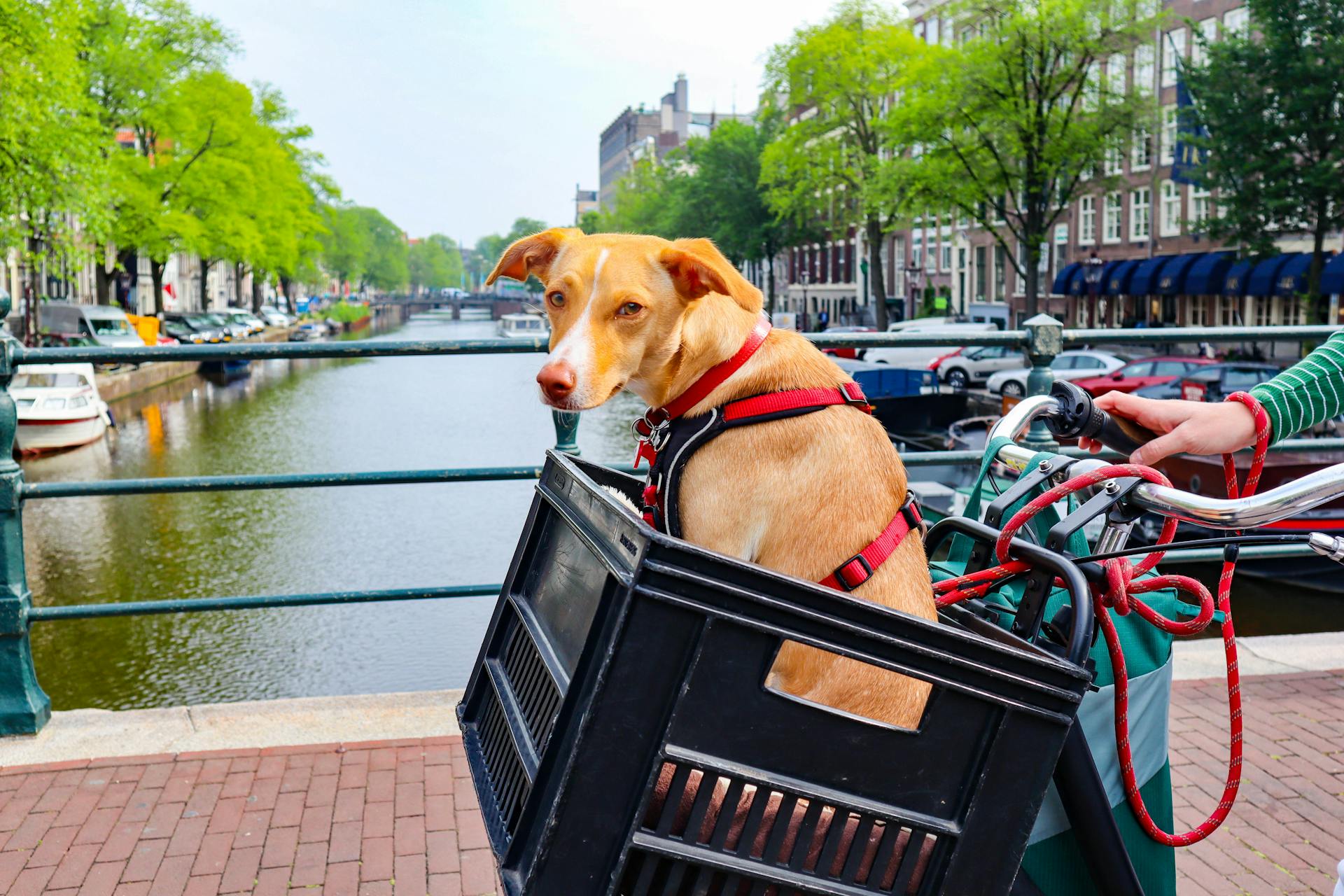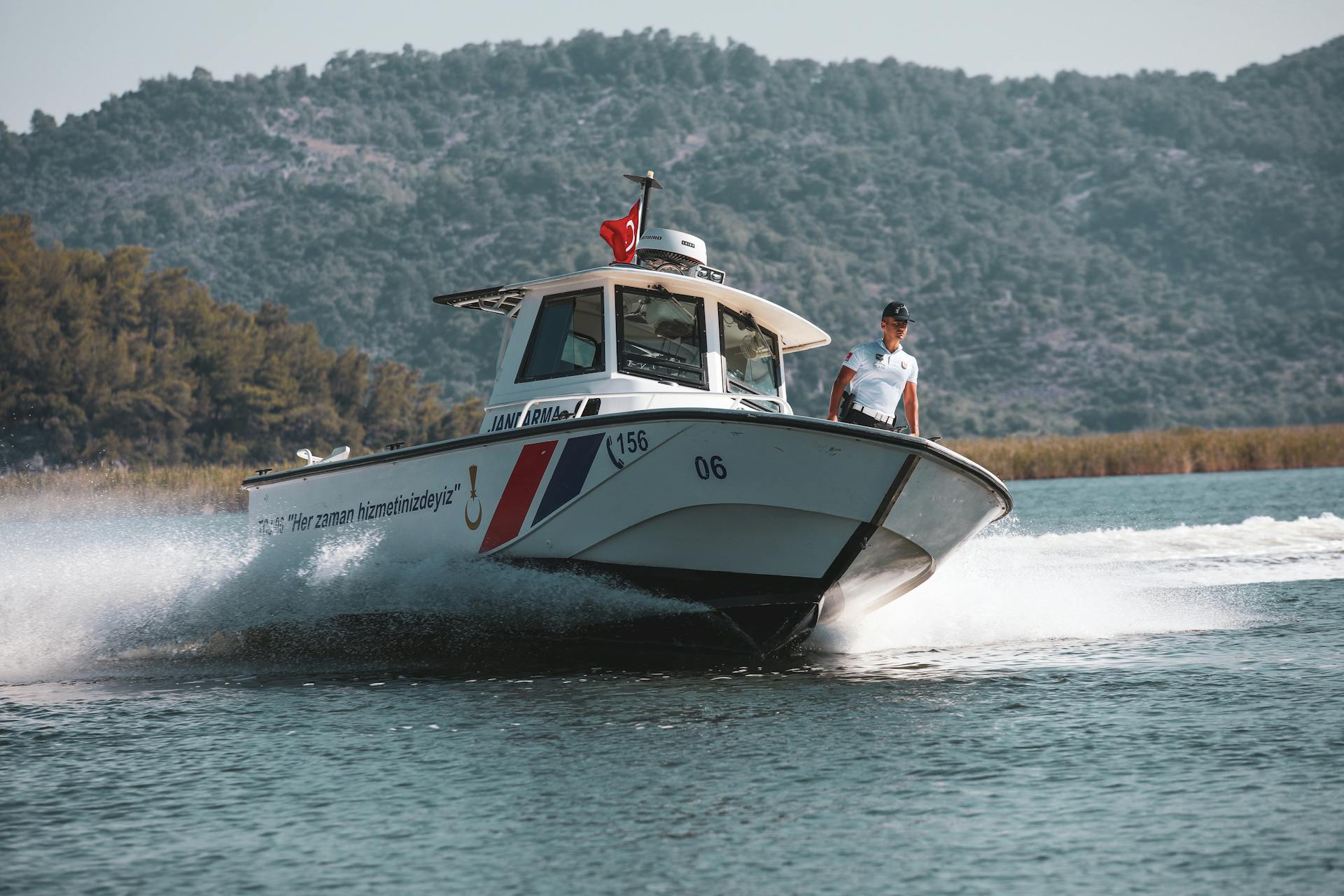
Transportation of animals requires careful consideration of the type of animal and the method of transportation. Livestock, such as cattle, pigs, and sheep, are often transported by truck or trailer.
The mode of transportation can greatly impact the animal's comfort and safety. For example, horses are typically transported in horse trailers, which provide a more stable and comfortable environment.
Different animals have different transportation needs, and it's essential to choose a method that meets those needs. Some animals, like birds and reptiles, may require specialized carriers or containers to prevent injury or escape.
Types of Animals
When transporting animals, it's essential to consider the type of animal you're moving. Some animals are fragile and require special care, like the gerbils that need a safe and quiet environment.
Cats are generally low-maintenance and can tolerate some noise, but they still need regular feeding and watering. Dogs, on the other hand, require more attention and exercise, making them a higher priority when it comes to transportation.
Horses, being large and powerful animals, require specialized transportation, such as horse trailers or equine vans. This ensures their safety and comfort during travel.
Zoo
Zoo animals can be quite a challenge to care for, especially when they're wild animals transported for display.
Some wild animals offer specific challenges due to their natural behaviors and habitats.
Elephants
Elephants are regularly transported for circuses and as working animals. Historically, war elephants were transported from their native countries to battlefields throughout the ancient world.
Ptolemy II Philadelphus had ships custom-built for transporting elephants in the 3rd century BCE. This shows that transporting elephants is not a new concept.
The transportation of elephants has often been contentious in modern times. In 2013, the CEO of Toronto Zoo stated that there are associated risks with moving elephants.
If an elephant panics during air transport, it may have to be euthanized, according to a Toronto Zoo board member. This highlights the challenges of transporting these large animals.
Giraffes
Giraffes are typically transported in custom-built containers or crates to account for their height. These special containers can be quite large, as seen in the case of Nakaru, a 15-month-old female giraffe, who was transported in a 4.2 metre crate.
Giraffes can be moved long distances, such as 322-kilometres, which is the distance Tonda, a 4.3-metre, three-year-old adult male, was moved from Paignton Zoo to Chessington Zoo.
Specialized transportation companies can handle these large animals, like the Dutch company that moved Tonda. They use specially built trailers with adjustable roofs to accommodate the giraffes' height.
Giraffes must also undergo quarantine periods after their move, which can last up to 30 days. This was the case for both Nakaru and Timmy, a 400-pound Baird's tapir, who was also moved as part of a breeding programme.
Aquarium
Aquarium animals are quite fascinating, and their transportation requires some careful planning.
Seals are often used in aquariums due to their ability to thrive in both water and on land, as long as they're kept cool and moist.
To transport seals, a water spray or placing ice above their container is a common method used to keep them cool.
Aquariums often use two techniques for moving large marine mammals: wet transit, where the animal is kept in a large tank of water, and dry transit, where the animal is placed in a padded sling and kept calm, wet, and cool by human assistance.
The choice between wet and dry transit depends on the size of the animal being transported and the distance to be traveled.
Other Whales
J.J., a young gray whale, was the largest animal ever transported, weighing 19,200 lb and measuring 31 feet in length.
She was carefully fitted into a custom-made transport sling and lifted by crane onto a 40-foot foam-padded trailer.
FedEx has successfully shipped at least seven whales to aquariums in slings inside metal containers with just enough water to keep the whales moist.
Rodents
Rodents are a type of animal that requires special care when transporting them outside of an animal facility. A secondary enclosure is always required, such as a drape, reusable container, or disposable box.
Transporting rodents through public areas can be a challenge, but it's essential to take precautions to avoid exposure to allergens and negative reactions from others. This can be done by using drapes, shrouds, or opaque secondary enclosures to obscure the animals from view.
Appropriate personal protective equipment (PPE) must be used to prevent cross-contamination among animals and between humans and animals. This includes using equipment to prevent the spread of pathogenic organisms and other biological materials.
To minimize the release of animal dander, airborne animal allergens, and animal bedding into the environment, filter tops or other effective covers should be used on rodent cages. Cages or carriers should also be covered during transport.
Temperature extremes must be avoided during transportation outdoors, as this can cause heat or cold stress in rodents. Climatic temperatures above 85 F or below 45 F require special precautions to protect the animals.
On a similar theme: Truck and Transportation Equipment
Transport Methods
International transport of animals can be a long and arduous journey, with many animals being flown to their destinations. Some animals, mainly cattle, are subjected to ocean journeys that can last weeks, exposing them to stressful experiences like inadequate ventilation, loud noises, and heat stress.

Many animals are shipped by sea, with over 503,000 cattle exported to countries other than Canada and Mexico since 2005 being shipped primarily to Russia and Turkey. In fact, most of the exported animals are flown to their destination, with some being shipped by sea.
The risks associated with international transport are significant, with over 1,000 breeding dairy cattle dying during a voyage to Russia in 2012. The incident was attributed to a breakdown in manure removal and ventilation systems, causing the animals to suffocate on ammonia fumes.
Transportation of animals
Transportation of animals can be a complex and stressful process for both the animals and their owners. Many animals, including livestock, pets, and even zoo animals, are transported by air or sea for various reasons.
International transport of farmed animals has increased significantly, with over 503,000 cattle exported to countries other than Canada and Mexico since 2005. These long-distance journeys can last weeks and expose animals to stressful experiences like inadequate ventilation, loud noises, and heat stress.
To minimize stress, transportation methods should maintain appropriate ventilation, avoid temperature and humidity extremes, and prevent exposure to pathogens. Animal enclosures should be securely situated in/on the transport cart or vehicle and kept clean and sanitized to prevent the spread of diseases.
Airline policies on transporting domestic pets vary, with some carriers allowing pets in passenger cabins or holds, while others decline to carry them at all. Specialist animal air transportation companies exist to ensure the safety and comfort of large and exotic animal passengers.
To protect animals during transportation, it's essential to follow general procedures, such as containing animals within or between buildings, minimizing stress, and preventing exposure to hazards. This includes using secure locking mechanisms, maintaining proper ventilation, and keeping animal cargo areas clean and decontaminated.
Here are some key considerations for transporting animals:
- Contain animals within or between buildings to prevent escape and protect personnel.
- Minimize stress through proper ventilation, temperature control, and noise reduction.
- Use secure locking mechanisms and keep animal enclosures clean and sanitized.
- Keep animal cargo areas clean and decontaminated before and after use.
Research
Research animals require special care during transportation. The Institute for Laboratory Animal Research of the United States National Research Council has produced guidelines for this purpose.
These guidelines help ensure the animals' safety and well-being during transportation.
Vehicle Use Procedures

When transporting animals in a vehicle, it's essential to follow specific guidelines to ensure their safety and well-being. Research institutions, like the Institute for Laboratory Animal Research, provide guidelines for the transportation of research animals.
The primary goal of vehicle use procedures is to minimize stress to the animals. This can be achieved by maintaining appropriate ventilation, avoiding extremes in temperature and humidity, and minimizing noise and odors.
To prevent escape and protect personnel, animals and their enclosures must be contained within the vehicle. This includes using locking mechanisms or latches that cannot be dislodged by movement.
Here are some key requirements for transporting animals in a privately-owned vehicle:
- The use of a privately-owned vehicle must be described in the animal use protocol and approved by the IACUC.
- Animals should not be placed in a closed trunk for transportation.
- Each individual transporting animals must submit a Transportation of Animals Using a Privately-Owned Vehicle Form as an attachment to the relevant animal use protocol.
- USDA-covered species can only be transported in vehicles that have been inspected and approved by personnel designated by the IACUC.
To ensure compliance, it's crucial to schedule an inspection of the vehicle prior to its initial use. Contact the Office of Animal Research Compliance at [email protected] to schedule an inspection.
Live Perishables Board
The Live Animals and Perishables Board, also known as LAPB, is a crucial part of ensuring the safe and humane transportation of live animals by air.
IATA coordinates the LAPB and provides key input to the airline industry on animal welfare, identification, and animal behavior based on modern science.
Governments set and enforce the rules concerning live animal transportation, but IATA publishes the Live Animals Regulations, which all IATA members must follow.
These regulations aim to ensure live animals are handled and transported in a way that prioritizes their welfare, safety, and health.
The Live Animals Transported By Air: Container Requirements and Statistics section highlights the importance of proper container requirements for live animals.
Consider reading: Transportation Management System Requirements
Regulations and Policies
Transportation of animals requires careful planning and adherence to regulations to ensure the safety and well-being of animals, personnel, and the public.
The Institutional Animal Care and Use Committee (IACUC) must approve the transportation of live animals between locations via vehicle. This is a critical step to prevent any potential risks or harm to the animals.
To transport animals via private vehicle, you'll need to complete the Personal vehicle transportation form. This form is essential to ensure that all necessary precautions are taken to prevent any harm or escape during transportation.
Private vehicles transporting USDA-regulated species must also be inspected to ensure they meet the required standards. This is a crucial step to prevent any potential risks or harm to the animals, personnel, and the public.
Here are some key resources to help you navigate the regulations and policies surrounding animal transportation:
- Animal Care Policies
- Animal Care Standards and Procedures
- Animal Care Forms, Checklists & Templates
- Animal Care Factsheets
- Animal Care FAQs
Regulations and Policies
The IATA Live Animals Regulations (LAR) are the worldwide standard for transporting live animals by commercial airlines, aiming to ensure safe and humane transportation.
The regulations cover all types of animals, including pets, animals for zoological or agricultural purposes, and more. They set standards for animal welfare and safety during transportation.
In the United States, international transport of farmed animals has increased significantly since 2010. Over 503,000 cattle were exported to countries other than Canada and Mexico between 2005 and 2012, with most being shipped by sea.
Ocean journeys can last weeks and expose animals to stressful experiences, including inadequate ventilation, loud noises, motion sickness, and heat stress. This can make them more susceptible to illness and disease.
For your interest: Department of Transportation Regulations for Truck Drivers
A notable incident in 2012 resulted in the deaths of over 1,000 breeding dairy cattle shipped to Russia from Galveston, Texas. The deaths were attributed to a breakdown in manure removal and ventilation systems.
The Animal Welfare Institute (AWI) recommends that no animals be transported such long distances and for such long periods. However, if they are, only fit animals should make the journey.
In response to AWI's petition, the USDA amended its regulations in 2016 to include fitness to travel criteria and a requirement that any deaths be reported within five days of the completion of an international journey.
Here are some key regulations and policies related to animal transportation:
- The USDA requires that only fit animals make international journeys.
- The IACUC must approve the transportation of live animals between locations via vehicle.
- Project personnel providing vehicular transportation for research or teaching animals must complete the Personal vehicle transportation form.
- Private vehicles transporting USDA-regulated species must be inspected.
Controversies
In 2018, United Airlines admitted to forcing a passenger pet to be stowed away in an overhead bin, resulting in the animal's death.
Two high-profile incidents involving United Airlines made headlines in 2018, highlighting the importance of responsible pet transportation.
Another dog aboard a United flight was mistakenly sent to Japan instead of its intended Kansas City destination just two days after the first incident.
In 2004, a change in EU law allowed ferrets to be transported within European Union borders, joining cats and dogs.
Currently, the EU's pet passport scheme only covers cats, dogs, and ferrets that have been vaccinated against rabies and fitted with electronic microchips.
Focus on Animal Safety and Welfare
Animal transportation by air has a long history, dating back to the early 1930s. Since then, it has become the most humane and efficient method of transporting animals over long distances.
Animals have been transported by air for nearly a century, and it's considered the best way to ensure their safety and welfare.
Featured Images: pexels.com


